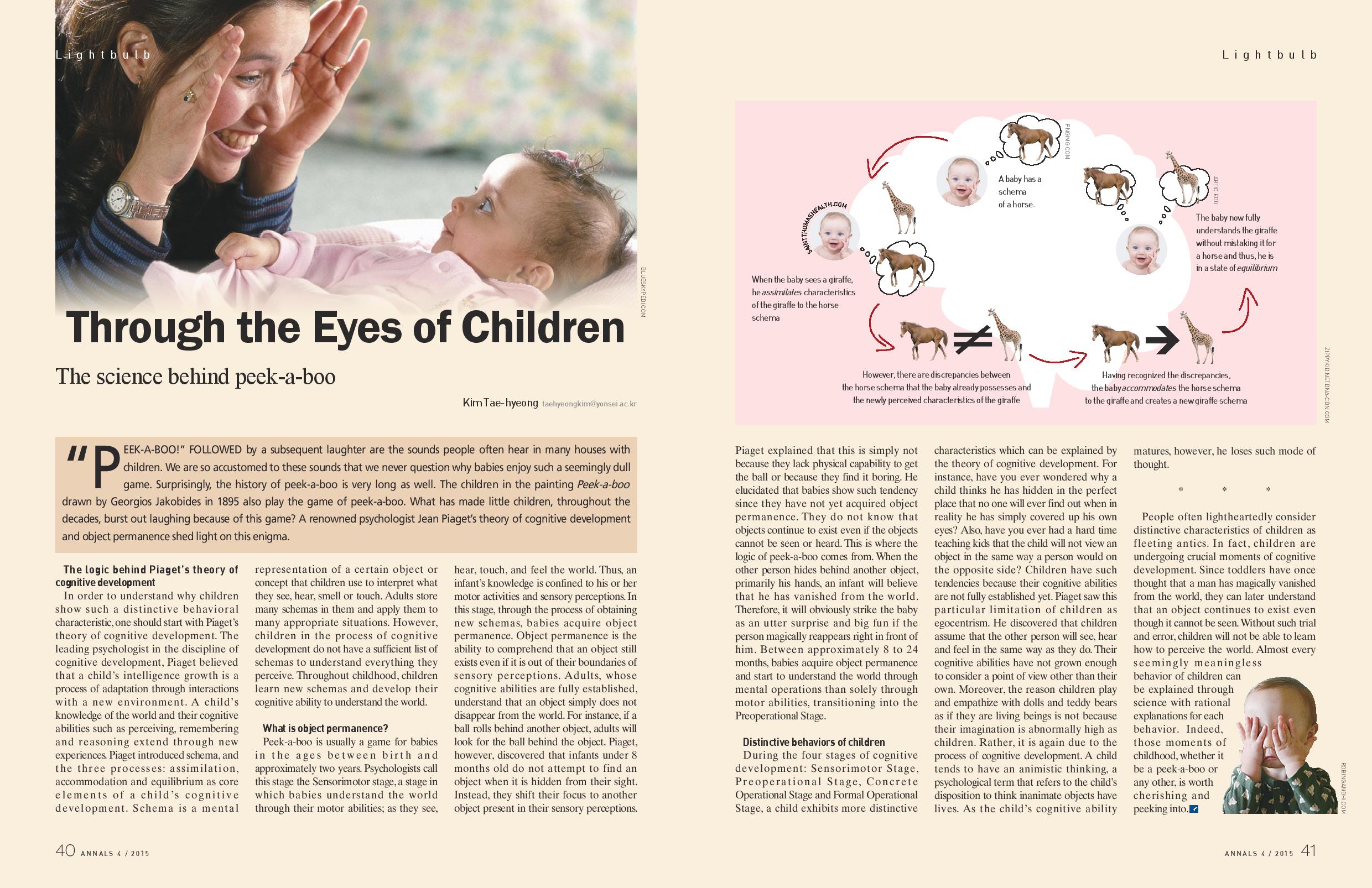The science behind peek-a-boo
 | ||
 | ||
“PEEK-A-BOO!” FOLLOWED by a subsequent laughter are the sounds people often hear in many houses with children. We are so accustomed to these sounds that we never question why babies enjoy such a seemingly dull game. Surprisingly, the history of peek-a-boo is very long as well. The children in the painting Peek-a-boo drawn by Georgios Jakobides in 1895 also play the game of peek-a-boo. What has made little children, throughout the decades, burst out laughing because of this game? A renowned psychologist Jean Piaget’s theory of cognitive development and object permanence shed light on this enigma.
The logic behind Piaget’s theory of cognitive development
In order to understand why children show such a distinctive behavioral characteristic, one should start with Piaget’s theory of cognitive development. The leading psychologist in the discipline of cognitive development, Piaget believed that a child’s intelligence growth is a process of adaptation through interactions with a new environment. A child’s knowledge of the world and their cognitive abilities such as perceiving, remembering and reasoning extend through new experiences. Piaget introduced schema, and the three processes: assimilation, accommodation and equilibrium as core elements of a child’s cognitive development. Schema is a mental representation of a certain object or concept that children use to interpret what they see, hear, smell or touch. Adults store many schemas in them and apply them to many appropriate situations. However, children in the process of cognitive development do not have a sufficient list of schemas to understand everything they perceive. Throughout childhood, children learn new schemas and develop their cognitive ability to understand the world.
Box 1:
A baby has a schema of a horse. When the baby sees a giraffe, he assimilates characteristics of the giraffe to the horse schema. However, there are discrepancies between the horse schema that the baby already possesses and the newly perceived characteristics of the giraffe. Having recognized the discrepancies, the baby *accommodates* the horse schema to the giraffe and creates a new giraffe schema. The baby now fully understands the giraffe without mistaking it for a horse and thus, he is in a state of *equilibrium*.
What is object permanence?
Peek-a-boo is usually a game for babies in the ages between birth and approximately two years. Psychologists call this stage the Sensorimotor stage, a stage in which babies understand the world through their motor abilities; as they see, hear, touch, and feel the world. Thus, an infant’s knowledge is confined to his or her motor activities and sensory perceptions. In this stage, through the process of obtaining new schemas, babies acquire object permanence. Object permanence is the ability to comprehend that an object still exists even if it is out of their boundaries of sensory perceptions. Adults, whose cognitive abilities are fully established, understand that an object simply does not disappear from the world. For instance, if a ball rolls behind another object, adults will look for the ball behind the object or even attempt to remove an obstacle to reach for the ball. Piaget, however, discovered that infants under 8 months old do not attempt to find an object when it is hidden from their sight. Instead, they shift their focus to another object present in their sensory perceptions. Piaget explained that this is simply not because they lack physical capability to get the ball or because they find it boring. He elucidated that babies show such tendency since they have not yet acquired object permanence. They do not know that objects continue to exist even if the objects cannot be seen or heard. This is where the logic of peek-a-boo comes from. When the other person hides behind another object, primarily his hands, an infant will believe that he has vanished from the world. Therefore, it will obviously strike the baby as an utter surprise and big fun if the person magically reappears right in front of him. Between approximately 8 to 24 months, babies acquire object permanence and start to understand the world through mental operations than solely through motor abilities, transitioning into the Preoperational Stage.
Distinctive behaviors of children
During the four stages of cognitive development: Sensorimotor Stage, Preoperational Stage, Concrete Operational Stage and Formal Operational Stage, a child exhibits more distinctive characteristics which can be explained by the theory of cognitive development. For instance, have you ever wondered why a child thinks he has hidden in the perfect place that no one will ever find out when in reality he has simply covered up his own eyes? Also, have you ever had a hard time teaching kids that the child will not view an object in the same way a person would on the opposite side? Children have such tendencies because their cognitive abilities are not fully established yet. Piaget saw this particular limitation of children as egocentrism. He discovered that children assume that the other person will see, hear and feel in the same way as they do. Their cognitive abilities have not grown enough to consider a point of view other than their own. Moreover, the reason children play and empathize with dolls and teddy bears as if they are living beings is not because their imagination is abnormally high as children. Rather, it is again due to the process of cognitive development. A child tends to have an animistic thinking, a psychological term that refers to the child’s disposition to think inanimate objects have lives. As the child’s cognitive ability matures, however, he loses such mode of thought.
* * *
People often lightheartedly consider distinctive characteristics of children as fleeting antics. In fact, children are undergoing crucial moments of cognitive development. Since toddlers have once thought that a man has magically vanished from the world, they can later understand that an object continues to exist even though it cannot be seen. Without such trial and error, children will not be able to learn how to perceive the world. Almost every seemingly meaningless behavior of children can be explained through science with rational explanations for each behavior. Indeed, those moments of childhood, whether it be a peek-a-boo or any other, is worth cherishing and peeking into.

